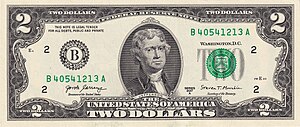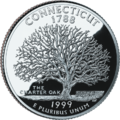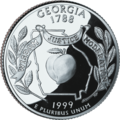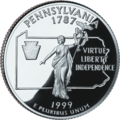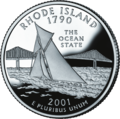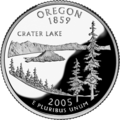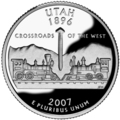Adventist Youth Honors Answer Book/Arts and Crafts/Currency (United States)
| Currency (United States) | ||
|---|---|---|
| Arts and Crafts General Conference |
Skill Level 2 | 
|
| Year of Introduction: 1945 | ||
|
The Currency (United States) Honor is a component of the Artisan Master Award . |
1. Relate briefly the story of barter, showing three reasons why money came into being and naming at least ten strange forms of money used in place of coins or currency.
[edit | edit source]Barter: as a dictionary puts it, barter is the exchange of something you own for something else that someone else owned. For example, if I raised chickens, and you grew apples, and I wanted some apples and you wanted a chicken, we would come to an agreement to exchange my chicken(s) for your apple(s).
After a while, I had enough of apples, and wanted something else. My other neighbor was vegetarian, and grew corn, but he did not want chickens. I found out that he also liked apples, so I bartered my chickens for your apples, and then traded the apples I got for my neighbor's corn. In a clumsy way, the apples were a medium of exchange, because they allowed me to trade for what I wanted. Unfortunately, you did not always want chickens, and apples were not always in season, so there were times in the year that I could not trade.
Simply put, a medium of exchange is a substitute used in trade to avoid the inconvenience of the barter system. This allowed the value of your apples, the corn, and my chickens to be valued differently. For example, I did not believe that I should only get one apple for one chicken. The chicken is bigger than an apple. Perhaps the first medium of exchange were stones. I would trade my chicken for four stones, and you would trade your apples for one stone, and the corn would be traded for two stones.
Very soon, we decided stones would not be a good medium of exchange, because:
- it was not very portable
- it could not be easily divided
- it was heavier than it was worth
- sometimes we could not recognize it
- and the neighbor's kid found a rockpile on the other side of the stream
Fast forward a few years, and currency has now been developed. Currency is a unit of exchange, which allows goods and services to be exchanged. It is one form of money (where money is anything that serves as a medium of exchange, a store of value, and a standard of value).
Unique forms of money
http://en.wikipedia.org/wiki/History_of_money
-
Shells
-
Salt
-
Spices
-
Pepper
-
Tobacco
-
Coca paste
-
Stone money
-
Trade beads
2. Relate briefly the history of coinage and paper currency in your country, making sure to mention the dates of the establishment of any mints or engraving plants. Also discover some change in the metal composition of a coin, giving any interesting highlights concerning such a change.
[edit | edit source]
United States Mint
[edit | edit source]The United States Mint primarily produces circulating coinage for the United States to conduct its trade and commerce. The main Mint facility is located in Philadelphia, Pennsylvania, and branch facilities are located in Denver, Colorado, San Francisco, California, and West Point, New York.
Mint marks in United States coinage include:
- P for the Philadelphia Mint,
- D for the Denver Mint,
- S for the San Francisco Mint,
- W for the West Point Mint,
- CC for the Carson City Mint,
- C for the Charlotte Mint, and
- O for the New Orleans Mint.
Most coins of the Philadelphia Mint earlier than 1980 are unmarked.
Current Facilities
[edit | edit source]The Mint's largest facility is the Philadelphia Mint, one of four active coin-producing mints. The current facility at Philadelphia, which opened in 1969, is the fourth Philadelphia Mint. The first was built in 1792, when Philadelphia was still the U.S. capital, and began operation in 1793. Until 1980, coins minted at Philadelphia bore no mint mark, with the exceptions of the Susan B. Anthony dollar and the wartime Jefferson nickel. In 1980, the P mint mark was added to all U.S. coinage except the penny. Until 1968, the Philadelphia Mint was responsible for nearly all official proof coinage. Philadelphia is also the site of master die production for U.S. coinage, and the engraving and design departments of the Mint are also located there.
The Denver branch began life in 1863 as the local assay office, just five years after gold was discovered in the area. By the turn of the century, the office was bringing in over $5 million in annual gold and silver deposits, and in 1906, the Mint opened its new Denver branch. Denver uses a D mint mark, and strikes coinage only for circulation. It also produces its own working dies ,as well as working dies for the other Mints.
The San Francisco branch, opened in 1854 to serve the goldfields of the California Gold Rush, uses an S mint mark. It quickly outgrew its first building and moved into a new facility in 1874. This building, one of the few that survived the great earthquake of 1906, served until 1937, when the present facility was opened. It was closed in 1955, then reopened a decade later during the coin shortage of the mid-60s. In 1968, it took over most proof-coinage production from Philadelphia, and since 1975, it has been used solely for proof coinage, with the exception of the Anthony dollar and a portion of the mintage of cents in the early 1980s. (These cents are indistinguishable from those minted at Philadelphia.)
The West Point branch is the newest branch mint. Its predecessor, the West Point Bullion Depository, was opened in 1937, and cents were produced there from 1973 to 1986. The West Point Mint gained official status as a branch mint on March 31, 1988. Along with the cents already mentioned, which were identical to those produced at Philadelphia, West Point has struck a great deal of commemorative and proof coinage bearing the W mint mark. In 1996, West Point produced clad dimes, but for collectors, not for circulation. The West Point facility is still used for storage of part of the United States' gold bullion reserves, and West Point is now the United States' only production facility for gold, silver and platinum American Eagle coins.
The Mint is not responsible for the production of paper money; that is the responsibility of the Bureau of Engraving and Printing.
Bureau of Engraving and Printing
[edit | edit source]
The Bureau of Engraving and Printing (BEP) is an government agency in the United States Department of the Treasury that primarily prints Federal Reserve notes for the Federal Reserve, but also produces a variety of other government security documents.
The Federal Reserve notes are printed at the bureau's facilities in Washington, D.C. and Fort Worth, Texas. The BEP produces other government products such as postage stamps for the United States Postal Service, hand engraved invitations on behalf of the White House, Treasury securities, identification cards, and naturalization certificates. The BEP does not produce any U.S. coins; that is the responsibility of the United States Mint. The Fort Worth facility was opened officially on April 26, 1991.
The BEP had its foundations in 1861 with workers signing, separating, and trimming sheets of Demand Notes in the Treasury building. In 1877, the Bureau became the sole producer of all United States bills and notes.
Coin Composition
[edit | edit source]In 1792, law was enacted which said that American money was to be made of gold, silver, and copper for the $10, $5, and $2.50 coins. The $1, half-dollar, quarter, dime, and half-dime were made of silver. The 1-cent and half-cent were made of copper.
During the Great Depression, the mint stopped producing gold coins (1933). In 1964 a silver crisis caused the replacement of silver in the quarter and dime, but the half-dollar's silver content was reduced from 90 per cent to 40 per cent silver from 1965 to 1970. Today, these coins are composed of cupro-nickel clad, with a pure copper core, and an outer layer of a 75 per cent copper, 25 per cent nickel alloy.
Nickels are also made from the 75-25 alloy, and the cent which was a copper coin, is now composed of copper plated zinc. The cents are less expensive to manufacture, and weighs 2.5 grams and is about 20 percent less than cent coins previously minted with 95 percent copper and 5 percent zinc, which weighed 3.11 grams. The composition of the cent was changed in 1982, and cents, and both copper and copper-plated zinc cents were produced in that year.
3. Explain how money is distributed in your country.
[edit | edit source]
Coin and currency are put into circulation by your banks (depository institution). These banks obtain the coins and currency from the Federal Reserve Banks. The Federal Reserve, the Bureau of Engraving and Printing (BEP), and the U.S. Mint do not release coins and currency direct to the public.
4. Define any of the following terms as they may apply to your country’s monetary system
[edit | edit source]- a. Alloy
- An alloy is a combination of two or more elements, at least one of which is a metal, and where the resulting material has metallic properties. The resulting metallic substance usually has different properties (sometimes significantly different) from those of its components. Nearly all coins are made of alloys.
- b. Cast Coins
- Coins which are made by pouring a molten alloy into a mold.
- c. Clad Coinage
- Coins made of layers, like a metal sandwich. Since the removal of silver from US dimes, quarters, half-dollars and dollars, these coins (except the smaller dollars) have been made of clad layers of nickel on the outside and copper on the inside. Look at the edge of the coins to understand.
- d. Commemorative
- Commemorative coins are legally issued coins with a design intended to commemorate or draw attention to some event or person. They are so called to distinguish them from regular issue coinage.
- e.Die
- An engraved tool used for stamping a design onto a coin.
- f. Field
- The field is the background—the part of the coin that shows no picture or words.
- g. Inscription
- An inscription is any letter, word, or phrase pressed into the surface of a coin.
- h. Lettered Edge
- A coins having letters written on its edge.
- i. Obverse
- The front side of currency or a coin (often called "heads" on a coin).
- j. Reeded Edge
- The reeded edges still found on many coins (always those that were once made of gold or silver, even if not so now) were originally designed to show that none of the valuable metal had been shaved off the coin. These show up as ridges along the edge of the coin.
- k. Reverse
- The back side of currency or a coin (often called "tails" on a coin).
- l. Series
- A particular design or motif used over a period of time. This can used for a single denomination, or in some cases, used for several denominations. The Liberty Seated series encompasses five denominations, the Barber series three, etc.
- m. Overprint
- n. Counterfeit proofing
- o. Magnetic strip
- p. Florescent ink
- q. Inflation controls
5. Describe the obverse and reverse for paper money of the six lowest denominations currently in use in your country.
[edit | edit source]| One Dollar Bill | |
|---|---|
 |
 |
| Five Dollar Bill | |
|---|---|
 |
 |
| Ten Dollar Bill | |
|---|---|
 |
 |
| Twenty Dollar Bill | |
|---|---|
 |
 |
| Fifty Dollar Bill | |
|---|---|
 |
 |
6. Know how coins are graded in quality by collectors.
[edit | edit source]Grading coins is an art that requires some skill. Anyone with some practice can get a fairly good idea as to the neighborhood of the grade of a coin. It's important to know the grade of a coin because, in general, the higher the grade of a coin, the higher its value.
United States coins are usually graded on a 70 point scale that was devised by Dr. William Shelby. 0 means that you can probably tell that it was once a coin, while 70 means that it is perfect. Some people, such as unscrupulous coin sellers, may overgrade coins so that they can sell them for more money than they are actually worth.
If you don't know how to grade coins, you should not buy coins without help. If you do not know how to grade coins for yourself, you will eventually learn, but the process could be expensive. Selling coins does not present as much of a problem. Just take the coins you want to sell to several different dealers to get their opinions as to the grade. Always ask for the grade opinion before asking for a price, as it can help in negotiating a fair price.
If you are interested in learning to grade coins yourself, you may want to start with the book titled "Official A.N.A. Grading Standards for United States Coins" published by the ANA.
Grade and Description
Cull (Mutilated coin) These coins are not just worn out, but may be bent, broken, stuck together, or incomplete.
PO-1 (Poor) Identifiable date and type
FR-2 (Fair) Mostly worn, though some detail is visible
AG-3 (About Good) Worn rims but most lettering is readable though worn
G-4 (Good) Slightly worn rims, flat detail, peripheral lettering nearly full
G-6 (Good) Rims complete with flat detail, peripheral lettering full
VG-8 (Very Good) Design worn with slight detail
VG-10 (Very Good) Design worn with slight detail, slightly clearer
F-12 (Fine) Some deeply recessed areas with detail, all lettering sharp
F-15 (Fine) Slightly more detail in the recessed areas, all lettering sharp
VF-20 (Very Fine) Some definition of detail, all lettering full and sharp
VF-25 (Very Fine) Slightly more definition in the detail and lettering
VF-30 (Very Fine) Almost complete detail with flat areas
VF-35 (Very Fine) Detail is complete but worn with high points flat
EF-40 (Extremely Fine) Detail is complete with most high points slightly flat
EF-45 (Extremely Fine) Detail is complete with some high points flat
AU-50 (About Uncirculated) Full detail with friction over most of the surface, slight flatness on high points
AU-53 (About Uncirculated) Full detail with friction over 1/2 or more of surface, very slight flatness on high points
AU-55 (About Uncirculated) Full detail with friction on less than 1/2 surface, mainly on high points
AU-58 (About Uncirculated) Full detail with only slight friction on the high points
MS/PR-60 (Mint State/Proof) No wear. May have many heavy marks/hairlines, strike may not be full
MS/PR-61 (Mint State/Proof) No wear. Multiple heavy marks/hairlines, strike may not be full
MS/PR-62 (Mint State/Proof) No wear. Slightly less marks/hairlines, strike may not be full
MS/PR-63 (Mint State/Proof) Moderate number/size marks/hairlines, strike may not be full
MS/PR-64 (Mint State/Proof) Few marks/hairlines or a couple of severe ones, strike should be average or above
MS/PR-65 (Mint State/Proof) Minor marks/hairlines though none in focal areas, above average strike
MS/PR-66 (Mint State/Proof) Few minor marks/hairlines not in focal areas, good strike
MS/PR-67 (Mint State/Proof) Virtually as struck with minor imperfections, very well struck
MS/PR-68 (Mint State/Proof) Virtually as struck with slight imperfections, slightest weakness of strike allowed
MS/PR-69 (Mint State/Proof) Virtually as struck with minuscule imperfections, near full strike necessary
MS/PR-70 (Mint State/Proof) As struck, with full strike
==
7. Have a coin or notes from 10 different countries. Describe what is on each, give the names of any people or objects portrayed on them, and give the dates for them whenever possible.
[edit | edit source]8. Do one of the following
[edit | edit source]a. Collect at least five coins or notes from your country that are no longer in circulation.
[edit | edit source]b. Collect a date series of coins from your country beginning with your birth year (expensive and rare coins need not be included)..
[edit | edit source]c. Collect and mount a type set of coins from your country minted during the 20th Century.
[edit | edit source]A type set is generally defined as a collection that contains one, and only one, of each design for a series or complete coinage series. A "complete" type set collection for the 20th Century would need to show all the designs of U.S. coinage minted from 1901 to 2000, and would be very difficult and costly to assemble. A "Lincoln Steel" type set would contain only the penny from 1943.
Here is a mostly complete list of the "type" coins required, collect one of each type:
Small Cents
- Lincoln 1909 V.D.B.
- Lincoln 1909-1958
- Lincoln 1943 steel
- Lincoln Memorial 1959-
5 Cent Nickels
- Liberty Head WC 1883-1912
- Buffalo Type 1 1913
- Buffalo Type 2 1913-1938
- Jefferson Wartime 1942-1945
- Jefferson 1938-
Dimes
- Barber 1892-1916
- Mercury 1916-1945
- Roosevelt 1946-1964 Silver
- Roosevelt 1965- Clad
Quarters
- Barber 1892-1916
- Standing liberty type 1 1916-1917
- Standing liberty type 2 1917-1930
- Washington 1932-1964
- Washington Clad 1965-98
- Bicentennial 1976 clad
- Bicentennial 1976 40% silver
- State quarters 1999 – clad
- State quarters 1999 – 90% silver
Half Dollars
- Barber 1892-1915
- Liberty Walking 1916-1947
- Franklin 1948-1963
- Kennedy 1964 Silver
- Kennedy 1965-70 40% silver
- Kennedy 1971-Clad
- Kennedy Bicentennial 1976 clad
- Kennedy Bicentennial 1976 40% silver
Dollars
- Morgan 1878-1921
- Peace High Relief 1921
- Peace 1922-1935
- Eisenhower 1971-1978 clad
- Eisenhower 1971-1978 40% silver
- Eisenhower Bicentennial 1976 clad
- Eisenhower Bicentennial 1976 40% silver
- Susan B. Anthony 1979-1999
- Sacagawea 2000 -
- Presidential dollars 2007 –
Quarter Eagles, $2.50 Gold Pieces
- Liberty Coronet 1840-1907
- Indian Head 1908-1929
Half Eagles, $5.00 Gold Pieces
- Liberty Coronet with Motto 1866-1908
- Indian Head 1908-1929
Eagles, $10.00 Gold Pieces
- Liberty Coronet 1866-1907
- Indian Head No Motto 1907-1908
- Indian Head 1908-1933
Double Eagles, $20.00 Gold Pieces
- Liberty Coronet 1877-1907
- Saint Gaudens Roman Numerals High relief 1907
- Saint Gaudens No Motto 1907-1908
- Saint Gaudens with motto 1907-1932
Bullion Coins
- One ounce silver $1.00 1986-
- Tenth ounce gold $5.00 1986-
- Quarter ounce gold $10.00 1986-
- Half ounce gold $25.00 1986-
- One ounce gold $50.00 1986-
- Tenth ounce-one ounce platinum $10.00-$100.00 1997-
Here's a suggestion for a series, "Washington" quarters:
-
Rel.Date: January 17, 2008
-
Rel.Date: March 30, 2008
-
Rel.Date: June 11, 2008
-
Rel.Date: August 23, 2008
-
Rel.Date: November 4, 2008
Notes:
- Washington Quarters were made of 90% silver up to and including 1964. You are competing with 'silver collectors' who collect these coins for their 'raw metal' value, which can be up to ten times the face value of the coin - $2.50 for a 25-cent quarter. See http://coinflation.com
- Roosevelt dimes were made of 90% silver up to and including 1964.
- The 1964 Kennedy half-dollar is also 90% silver. The Franklin half-dollar(s) before that were also 90% silver.
- There is no Washington Quarter with a 1975 date. For 1975 and 1976, the US Mint stamped out the Bicentennial Quarter design which showed a date '1776 - 1976'. Unless you have a proof set that shows that it was released specifically in 1975 and 1976, you cannot tell the difference in the circulated coins.
- Nickels minted from 1942-1945 during World War II contain 1.75 g (0.05626 oz) silver. The silver content of these "war nickels" as of October, 2007 is worth $0.77.
- As of October 2007, the value of the metal in the nickel coin has reached 6.8 cents, a 36% premium over its face value, due to the rising costs of copper and nickel against a falling U.S. Dollar. In an attempt to avoid losing large quantities of circulating nickels to melting, the United States Mint introduced new interim rules on December 14, 2006 criminalizing the melting and export of pennies and nickels. Violators of these rules can be punished with a fine of up to $10,000, five years imprisonment, or both.
- The Coinage Act of 1965, Pub.L. 89-81, 79 Stat. 254, enacted 1965-07-23, eliminated silver from the circulating dimes and quarter dollars of the United States, and diminished the silver content of the half dollar from 90% to 40%. This act was in response to coin shortages caused by the rising price of silver.
References
[edit | edit source]Note: Facts About United States Money (free), Office of the Secretary of the Treasury, U.S. Treasury Department, Washington, D.C. 20025. Facts about your country's currency may be obtained from the government treasury department.
- Book:Adventist Youth Honors Answer Book/Artisan Master Award
- Book:Adventist Youth Honors Answer Book/Honors
- Book:Adventist Youth Honors Answer Book
- Book:Adventist Youth Honors Answer Book/Skill Level 2
- Book:Adventist Youth Honors Answer Book/Honors Introduced in 1945
- Book:Adventist Youth Honors Answer Book/Arts and Crafts
- Book:Adventist Youth Honors Answer Book/General Conference
- Book:Adventist Youth Honors Answer Book/Completed Honors







